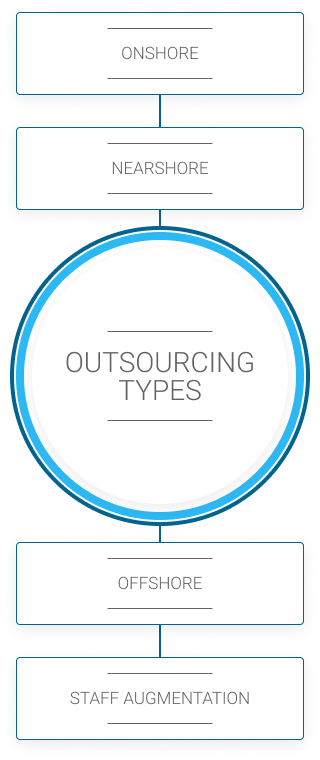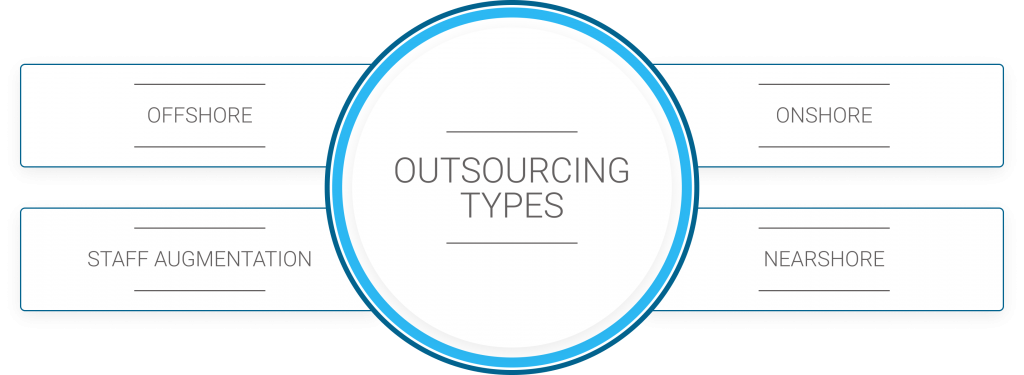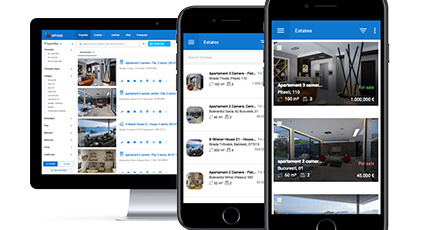There is no such thing as “perfect services” or “perfect solutions”. But outsourcing can become a real blessing when a company finds the right provider.
Onshore, offshore, nearshore, staff augmentation, dedicated teams…if you are just about to begin your first journey in outsourcing services, all these terms may seem pretty overwhelming.
And, if you’ve already experienced working with external dev teams on projects, you’re aware that accessing the right services it’s not as easy as it may seem.
A significant part of our clients came to us after experiencing outsourcing with other providers. (As you may predict, not always good experiences.) And each new client came with his specific pain-points related to the development process, the team, the technologies or the methodologies used by the outsourcing provider.
Once, one of our clients (who had to change the outsourcing providers many times from…various reasons) told us, “Outsourcing providers are like lottery tickets. You choose one and hope for the best.”
We instantly understood then (and we know it’s still a valid challenge for various companies today) that this was the conclusion resulting from long and tiring attempts to maintain relationships with providers.
As we told him then…
“Outsourcing is far from being a lottery ticket. Counting on outsourced services is not a blind choice. It’s more a matter of decoding in time if the provider responds to your specific expectations.”
So, this article aims to help you identify your specific pain-points to get the right services and the right outsourcing provider.
(And these two concepts are strongly related, taking into account that a reliable provider will be able to identify your needs and recommend the services that are the right fit for your goals.)
Most common software outsourcing pain points
Two types of pain-points reveal themselves as obvious when it comes to outsourcing: general pain-points (perceived by companies from different industries / of different sizes), and service-related pain-points (more specific).
Let’s start with the general ones:
Understanding the requirements and translating them into doable solutions. This may be one of the toughest challenges the companies deal with when it comes to outsourcing. The lack of expertise in a specific industry, the rush of making the leap from requests to solutions, the tendency to frame a project in a template – all these approaches can have a negative impact on your project. The results? Lack of clarity on deliverables, no good match between expectations and delivered solutions, lack of vision (solutions and innovations that go beyond documentation), solutions with a short lifespan/ that must be re-written to respond to specific contexts and needs.

Keeping you informed constantly on the project’s status and needs Your interventions can be extremely important in some points of the projects. Let’s say the provider didn’t understand some specific requirements that must be accomplished in a project stage. Bad implementations lead to higher costs and significant delays.

Unpredicted delays and delivery times exceeded. Not often enough projects are delivered on time. But, still, there’s a big difference between delaying 2-3 days and delivering 3 months after the settled deadline. And things become even more complicated when the provider realizes that it can’t handle the project after the contract is signed.

Over promises and under deliveries For the sake of selling, some providers are ready to promise you anything you want to hear. Relying only on words is almost always risky. The most common disadvantages: projects fallen behind schedule, were rushed, are full of defects, etc.

Who’s taking over what? When the responsibility is not well defined, there will almost always be big problems. If it’s not clear enough who’s responsible for the team management, research, development, and testing of that product, sooner or later, you should expect to deal with some important issues.

Using the wrong outsourcing model The first question you must ask yourself is: Which outsourcing model do you need? From one project to another, needs can be different – so there’s no general answer.

Onshore vs offshore vs nearshore vs. staff augmentation. What’s the difference?
When it comes to specific pain-points, the very first thing you must consider is the outsourcing type.

Check out each model described below to identify what suits your company’s needs best.
Criteria to consider while analyzing which one fits best your company’s needs
- quality of the services
- quality-costs ratio
- communication system
- business scalability
Challenges related to Onshore outsourcing
- What is onshore outsourcing?
Onshore software development means choosing a provider that is close to your office (located in your home country). - Onshore software outsourcing benefits
- working culture similarities;
- common language;
- transferred liability;
- same time zone;
- fast direct interactions;
- skilled teams from your country.
-
What are the most common pain-points related to this outsourcing type?
- higher costs;
- limited providers choices – limited skill set;
- infrastructure cost for additional teams.
- How to outcome these challenges?
Negotiate the working terms through a cross-promotion offer (cross recommendations, referrals to other clients, etc.)
Challenges related to Offshore outsourcing
- What is offshore outsourcing?
Offshore means working with a software development provider outside your country, usually from a different time zone. - Offshore software outsourcing benefits
- significantly reduced costs;
- full disponibility;
- transferred liability;
- no legal issues bottlenecks;
- wide-range of skills;
- great cost-quality balance;
- higher scalability;
- higher adaptability to dynamic requirements.
-
What are the most common pain-points related to this outsourcing type?
- communication differences (if it is not used a common language, as English);
- cultural differences (depending on the country);
- different time zones (depending on the country);
- quality control is more complex.
- How to outcome these challenges?
Choose a provider that is in the same time zone as you (or with small differences) and that manages teams able to communicate easily in a known language (e.g., English).
Challenges related to Nearshore outsourcing
- What is nearshore outsourcing?
Nearshore outsourcing means working with a provider that is located in a neighboring country to yours. - Nearshore software outsourcing benefits
- same time zones;
- good cost-quality ratio;
- transferred liability;
- fast direct interactions.
- What are the most common pain-points related to this outsourcing type?
- different working culture;
- communication barriers;
- infrastructure.
- How to outcome these challenges?
Choose a provider that manages teams able to communicate easily in a known language (e.g., English) and check his portfolio to see if his development vision is the same as yours.
Challenges related to staff augmentation
- What is staff augmentation?
Staff augmentation means extending an existing team with external professionals to bring additional skills that are required for a specific project. - Staff augmentation software outsourcing benefits
- high flexibility;
- no recruitment investments;
- lower expenses;
- performant staff management.
- What are the most common pain-points related to this outsourcing type?
- more time invested in team management ( align workflow, track tasks deliveries, etc.);
- data privacy risks;
- bottlenecks in communication (language used, tools for exchanging information and interact, etc.);
- skills coordination (known technologies, methodologies, etc.)
- How to outcome these challenges?
The most important issue may be data privacy. To avoid any risks, make sure NDA contracts and rules protect your data.
From the team management perspective, you must consider working with PMs (project managers) who have previous experience working with additional staff.
Why do companies choose to outsource?
The following situations describe the most common contexts when outsourcing is needed:
- the new (social and economic) context generates an unpredictable market dynamic. This dynamic directly influences your business evolution by:
- forcing your company to operate in new ways;
- determining you to re-prioritize your business with a digital focus;
- generating urgency in developing a rapid response to the current disruptions;
- managing the transition to new work models (work from home, hiring external teams, etc.).
- the competition became tougher – If you are working for a software development company, you are aware that every project counts. While all your competitors will try to attract new projects through persuasive arguments like costs and extended capabilities, you have to adapt fast to the clients’ specific needs and expectations and be ready to offer them a complete and competitive package of services.
- you need to rely on long-term profit – maintaining a good relationship with clients can guarantee you a long-term profit as long as you are able to respond fast to their contextual needs with a smart price-quality ratio.
The outsourcing services are chosen by various companies and industries all over the world. But, as you may expect, some of them are more interested than others.
Let’s take a quick look at what stats say about it.
Types of companies that prefer working with external software development providers:

Industries that are more interested in hiring external dev teams.

Here are 3 examples of key-challenges that led to outsourcing:
#1 Legacy code/Outdated solution: VMS 365
At the moment we’ve started working on this project, the client was involved in a rebranding process and was looking for software development services at high standards.
The previous provider’s lack of responsiveness in adapting the existing solution to the new requirements determined nGage to search for a new company to work with. See how we responded to our client’s challenges.
#2 Outdated and inflexible desktop solution – WHISE
The client needed to upgrade the application and have it built mobile-first in order to be able to access other markets outside of Belgium, particularly in Romania. At the same time, they needed to seamlessly migrate approximately 600 Belgian real estate companies in their existing user database into the new application. Read the full case study.
#3 Disparate data sources – Tourpaq
Tourpaq needed an up-to-date Tour Operator Management System that would enable the users to manage everything that has to do with their activity from a single dashboard. See the project.
See more projects from our portfolio
How to choose the model that fits your company’s needs best?
Outsourcing models:
Dedicated team
- the client-company pays a monthly salary to the hired specialists plus administrative costs;
- the model is suitable for long-term projects and complex project where the company needs additional expertise;
- the client has full control over the development process.
Time and material
- the company pays exclusively for the development time invested;
- the model can be used for completing the resources that are missing from a project;
- the model is suitable for less complex projects with predefined requirements.
Fixed-price
- suitable for small projects that allow accurate estimations (for costs, time, resources used, etc.)
- great control over the delivery time – the projects are delivered on a pre-agreed timeframe
- this model is useful for testing the impact of new products on specific audiences (software, apps, etc.)
There are some reliable sources from where you can pick potential development providers for your project. (preferable to find the same recommended providers in as many trustworthy places as possible)
- outsourcing companies recommended by your industry colleagues;
- dedicated platforms (GoodFirms, Clutch, The Manifest, etc.);
- valuable tech content (from blogs, news websites, etc.);
- professional networking platforms (e.g., LinkedIn)
- tech events (e.g., GITEX, MWC, etc.).
Selecting the right outsourcing company: top criteria you must take into account
- 10+ y of experience on the IT market – a guarantee that experienced teams will take over your project;
- various projects in the company’s portfolio – illustrative both for dedicated teams and for your industry;
- large and stable number of employees – the more employees a company has, the easier will be for it to provide you the team you need;
- team roles provided by the company – an extra-guarantee that you can count on a complete team for developing your project;
- disruption-free recruitment projects – recruitments processes based on modern and efficient technologies.
Our outsourcing story: what is our approach in providing outsourcing services to our clients?
Roweb is a custom software development company, started in 2004 with offices in 4 major cities: Bucharest, Pitesti, Craiova and Ramnicu Valcea.
With our 130+ IT professionals’ experience and the latest software development technologies, we focus on building Business, Web, Mobile applications, and E-commerce solutions.
We work with companies from all over the world, and we understand the needs of and provide solutions for companies of all sizes ranging from start-ups to large business.
“I started the company in 2004 with the business purpose of creating software that would solve the client’s problems. The idea behind this was a company that would offer competitive services, from a quality and price point of view, to build a portfolio of clients with whom to grow and develop ourselves and grow together with our businesses. We are dedicated to staying ahead of the rapid changes by working with the latest technologies so that our clients would benefit from our technology expansion.
Our mission is to continually keep up with the innovations in the technological world so that the developed software does well in the market.”
Viorel Costea | Co-Founder & CEO Roweb
(Read more about our outsourcing models and services from the article Dedicated team model: our approach (interview + case studies)
We have an in-house team of software professionals who manage end-to-end product development projects, from business analysis, consultancy, and architecture, to post-implementation testing and maintenance.
“We are always interested in building long-lasting teams. It is essential to save the project’s optimal cost, so we consider the different levels of tasks required by the project, their duration, and workload. For most projects, the best team configuration includes junior, middle, and senior developers. Our employer branding strategy implies hiring junior developers from the university, and we continuously invest in their professional growth.”
Viorel Costea | Co-Founder & CEO Roweb
Need support for starting a new outsourcing-based project? Book a free consultation session with one of our experts!





